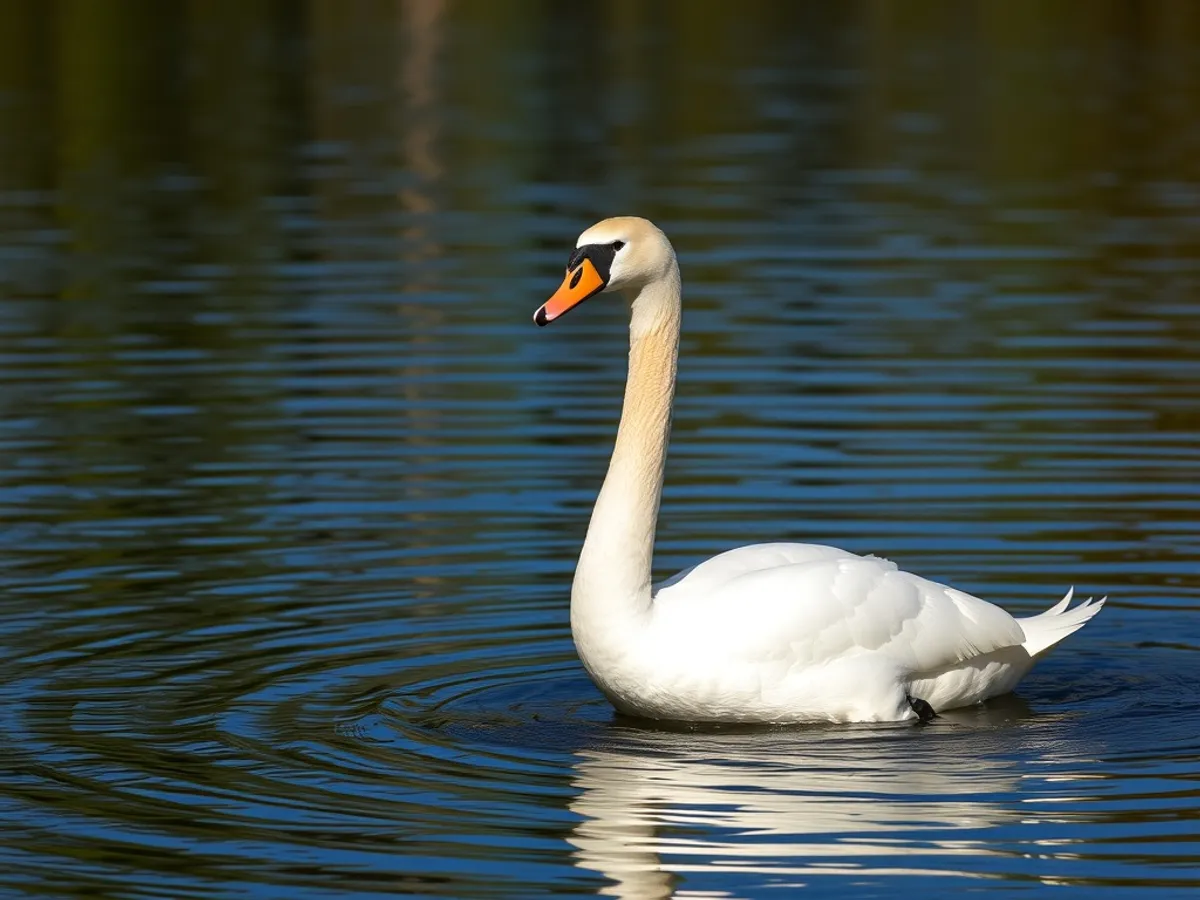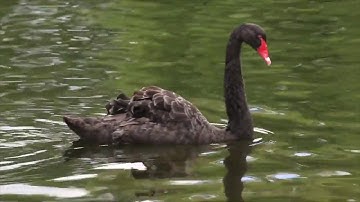
Mute Swan
Cygnus olor

Meet the Mute Swan
The Mute Swan is a large, graceful waterfowl native to much of Europe and Asia, and introduced to North America and other regions. Recognizable by its pure white plumage, long curved neck, and distinctive orange bill bordered with black, it is one of the heaviest flying birds. Despite its name, the Mute Swan is not entirely silent, but is less vocal than other swan species, often communicating with hissing or grunting sounds. These swans are often seen gliding majestically on lakes, ponds, and slow rivers, where they feed mainly on aquatic vegetation.
Classification
Bird
Habitat
Freshwater lakes, ponds, rivers, and marshes
Diet
Herbivore
Lifespan
10-20 years in the wild
Conservation
Least Concern
Weight
9-14 kg
📖Fascinating Facts
Heavyweight Flier
Mute Swans can weigh up to 14 kg (over 30 pounds), making them among the heaviest birds capable of flight.
Large Clutches
A female Mute Swan (pen) typically lays 5-7 eggs per clutch, and both parents share in raising the cygnets.
Aquatic Diet
Their diet consists mainly of submerged aquatic plants, which they reach by upending—tipping forward in the water to graze on the bottom.
📋Detailed Description
The Mute Swan (Cygnus olor) is one of the largest and most recognizable waterfowl species, with adults typically measuring 125–160 cm (49–63 in) in length and boasting a wingspan of 200–240 cm (79–95 in). Males, known as cobs, are generally larger than females (pens), with the largest individuals weighing up to 15 kg (33 lbs), making them among the heaviest flying birds. Their plumage is entirely white, contrasting with an orange bill bordered by black and topped with a prominent black basal knob, which is more pronounced in males and swells during the breeding season. The neck is long and gracefully curved, often held in an elegant S-shape, a posture that is both a display and a defensive stance. Mute Swans are primarily herbivorous, feeding on submerged aquatic vegetation, which they access by upending in shallow water or grazing on land. They are territorial, especially during the breeding season, and will aggressively defend their nesting sites with threat displays and, if necessary, physical attacks. Socially, they are monogamous and often form lifelong pair bonds, with both parents participating in nest building and cygnet rearing. Their vocalizations are limited compared to other swans, consisting mainly of hissing, grunting, and wing-beat sounds, the latter audible from a considerable distance during flight. Juveniles, called cygnets, are covered in gray down and gradually acquire their white adult plumage over the first year.
💡 Did you know?
Mute Swans can be highly territorial and aggressive, often defending their nesting sites vigorously against intruders, including other swans and even humans.
🔬Research & Sources
Wikipedia Summary
The mute swan is a species of swan and a member of the waterfowl family Anatidae. It is native to much of Eurasia, and the far north of Africa. It is an introduced species in North America, home to the largest populations outside of its native range, with additional smaller introductions in Australasia and southern Africa. The name "mute" derives from it being less vocal than other swan species. Measuring 125 to 160 cm in length, this large swan is wholly white in plumage with an orange beak bordered with black. It is recognisable by its pronounced knob atop the beak, which is larger in males.
Last Modified: 5/16/2025
🎭Behavior & Social Structure
Mute Swans are diurnal and spend much of their day foraging for aquatic plants, algae, and occasionally small invertebrates. They feed by dipping their long necks underwater or upending in shallow areas, and may also graze on land. Outside the breeding season, they may gather in flocks, especially in winter, but during the nesting period, pairs become highly territorial and will chase away intruders, including other swans and large waterfowl. Their threat displays include arching the neck, raising the wings over the back, and hissing. Mute Swans are strong fliers, but their large size requires a long running takeoff across water. They maintain and defend territories year-round in some regions, while in others, especially in colder climates, they may migrate short distances to find open water. Daily routines include preening, bathing, and resting on water or land, often with one leg tucked up to conserve heat.
👶Reproduction & Life Cycle
Mute Swans form monogamous pairs, often maintaining bonds for life. Courtship involves synchronized swimming, mutual preening, and head-dipping displays. Breeding typically occurs from late March to early May, depending on latitude. Nests are large mounds of vegetation built near water, often reused or refurbished each year. The female lays 4–7 pale greenish or bluish eggs, which she incubates for 35–41 days while the male guards the territory. After hatching, cygnets are precocial and leave the nest within a day, swimming and feeding under parental supervision. Both parents are highly protective, leading their brood and defending against predators. Fledging occurs at 4–5 months, after which juveniles may remain with the parents through their first winter.
🛡️Adaptations & Survival
Mute Swans exhibit several adaptations for aquatic life and survival. Their long, flexible necks allow them to reach submerged vegetation inaccessible to many other waterfowl. Webbed feet provide powerful propulsion in water, while their large wings enable sustained flight despite their weight. The dense, waterproof plumage insulates against cold water. The pronounced bill knob may play a role in sexual selection and signaling. Behavioral adaptations include aggressive territoriality, which reduces competition for resources during breeding. Their relatively silent nature may reduce detection by predators, and their cryptic gray juvenile plumage offers camouflage for cygnets.
🎨Cultural Significance
The Mute Swan holds a prominent place in European folklore, art, and symbolism, often representing grace, beauty, and fidelity. In the United Kingdom, all unmarked Mute Swans on open water are considered property of the Crown, a tradition dating back to the 12th century. Swans feature in numerous myths, such as the Greek legend of Leda and the Swan, and are national symbols in countries like Denmark and Finland. Their image is widely used in heraldry, literature, and ballet, most famously in Tchaikovsky's 'Swan Lake.' Historically, swans were kept for food and ornamental purposes, though today they are protected in many regions.
🔬Recent Research & Discoveries
Recent research has focused on the ecological impacts of introduced Mute Swan populations, particularly in North America, where they alter wetland ecosystems and outcompete native species. Genetic studies have explored population structure and hybridization with other swan species. Studies on their aggressive territorial behavior have provided insights into avian social dynamics. Ongoing research includes monitoring the effects of climate change on migration patterns and breeding phenology, as well as the consequences of lead exposure and disease (such as avian influenza) on swan health and population viability.
🎥Wildlife Videos

Nature Documentary - Our Mute Swan Diary of 2023
Hello everyone, This is our Mute Swan Nature Diary for the first part of 2023 - documenting the lives of our four Mute Swan pairs ...
N.B. Nature Trailvan

The Circle of Life - a Mute Swan Diary 2022. Our Wildlife Documentary.
Hi everyone, It has been our privilege to follow along with the Mute Swans around here, over the last three years. We've learned ...
N.B. Nature Trailvan

Wildlife Documentary: Mute Swan -- with subtitles
From this point the sole focus of this documentary will be the mute swan. Due to its omnipresence in Europe's water habitats and ...
Amber Hawkins

Mute Swan - 5 Minute Documentary
Embark on a serene five-minute journey into the elegant world of the Mute Swan with a captivating documentary that reveals the ...
Five Minute Documentaries

wildlife documentary 'Mute Swans'
duration 3' 10" trailer for a documentary, produced by EYESEALAND wildlife cameraman and editor- Pieter Huisman Canon ...
EYESEALAND Visual Media

Short documentary: Life of a swan family
I have been following this one swan family since 2020. They have tried many times to raise a family, and have had beautiful ...
Ryan and Michelle
🌍Habitat Information
The Mute Swan typically inhabits Freshwater lakes, ponds, rivers, and marshes environments. Mute Swans have adapted to their environments with specialized features and behaviors.
Primary Habitat:
Freshwater lakes, ponds, rivers, and marshes
More detailed habitat information will be available soon.
🛡️Conservation Status
The Mute Swan is currently classified as Least Concern. Conservation efforts are crucial for preserving this species for future generations.
Common Threats:
- 🏠Habitat loss and fragmentation
- 🌡️Climate change impacts
- 🎯Hunting and poaching
- 🏭Human-wildlife conflict
⚠️Threats & Conservation Challenges
While globally listed as Least Concern, Mute Swans face localized threats. Habitat loss due to wetland drainage, water pollution, and disturbance from human recreation can impact breeding success. Lead poisoning from ingesting fishing weights and shotgun pellets remains a concern in some regions. Collisions with power lines and boats, as well as predation of eggs and cygnets by foxes, raccoons, and large birds, pose additional risks. In areas where they are introduced, such as North America, Mute Swans are considered invasive, competing with native waterfowl and damaging aquatic vegetation, leading to management and population control efforts.
🔬Scientific Classification
Scientific Name
Cygnus olor
Classification Hierarchy
🔍 About Taxonomic Classification
Taxonomic classification is a hierarchical system used by scientists to classify and organize living organisms based on shared characteristics and evolutionary relationships.
The system moves from broad categories (Kingdom) to increasingly specific ones, with each animal's scientific name typically consisting of its Genus and species.
📝Community Notes
Share your observations and insights about the Mute Swan with our community of wildlife enthusiasts.
Join Our Community
Sign in to share your observations and connect with fellow wildlife enthusiasts.
Sign In to ContributeNo community notes yet
Be the first to share your observations about the Mute Swan!
Explore Mute Swan
Select a tab above to learn more about this amazing animal.
📸Photo Gallery
No photos available for this animal yet.
🌟Discover More Wildlife
Continue your journey of discovery with more fascinating animals from our database
